Curries, snakes and monsoons: Helping Indian farmers progress
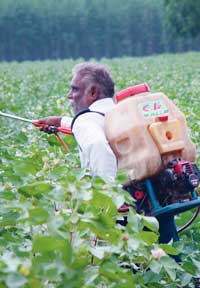
In November 2009 I flew out to Mumbai (Bombay) with Paul Miller of The Arable Group to spend a week with BASF India.
We were helping support its launch activities for Stomp Xtra (a weed-killer similar to BASF UK’s Stomp) as well as to give advice on best practice for the safe use of pesticides and environmental stewardship.
Nothing can really prepare you for the first time that you arrive in India. Its cultural richness and diversity is incredible, but getting off the plane in Mumbai what initially hits you is the smell that results from 20m people in one city – and the pollution caused by what is laughably called a traffic system. The M25 has nothing on Mumbai where every conceivable form of transport seems to exist from the most modern Japanese car to carts pulled by oxen.
It would also be wrong not to mention poverty and the shock that you feel when you first encounter it albeit in a relatively protected bubble from a car or hotel lobby. Young children being washed in open sewers alongside expensive shopping malls – what I think hit us was the extremes. India as a whole has a population of over 1bn people and the numbers are growing.
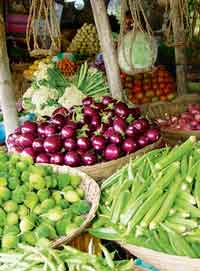 Indian agriculture and its allied sectors are the mainstay of the economy contributing nearly 22% of GDP with close on 70% of the population dependent on agriculture for their livelihood.
Indian agriculture and its allied sectors are the mainstay of the economy contributing nearly 22% of GDP with close on 70% of the population dependent on agriculture for their livelihood.
India has 182mha of cultivated land divided into 106m holdings. A large farm is about 50ha while a “smallholding” is smaller than many UK gardens.
In the 2007-08 season food grains alone accounted for 230m tonnes of production with the main cultivated crops being soya, rice, wheat, sugar cane, cotton and speciality crops such as chillies, potatoes and aubergines.
Paul and I had a challenging itinerary and travelled virtually from one side of India to the other. We started in Mumbai, before travelling to Indore and Bhopal, which is mainly a wheat and soya growing area and then further south to Hyderabad, Gunter and Vijayawada, where they grow paddy rice, cotton, maize and speciality crops. Gunter is one of the main chilli growing areas, which we can pay testament to, having sampled probably the hottest curries of our lives.
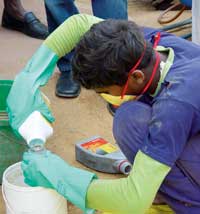 There was a clear divide from north to south with areas around Bhopal having farmers with very basic and old equipment treating seed by spreading it on a plastic sheet and spraying it with a knapsack sprayer. It was always the youngest member of the group we met that had to mix it by hand.
There was a clear divide from north to south with areas around Bhopal having farmers with very basic and old equipment treating seed by spreading it on a plastic sheet and spraying it with a knapsack sprayer. It was always the youngest member of the group we met that had to mix it by hand.
In contrast further south the soil was very fertile and productive with mountains either side of the plains. Rainfall there could be managed to provide irrigation systems for rice fields and to maintain high value crops such as chillies for export.
Nearly 60% of India’s cultivated area is rain-fed. Farmers are wholly dependent on monsoon rains to increase the water table for the season ahead. Generally they can achieve two crops per season.
I think for the first time we realised the true impact of climate change on agricultural systems. In the UK we are pretty protected from the extremes of climate change despite what we might think.
In comparison the monsoon rain is increasingly temperamental and variable, arriving later and often lasting for less time. It is not hard to see what a devastating impact a poor, or even non-existent monsoon would have on crop production and the Indian economy, particularly if it meant the loss of one of the two cropping cycles within a season.
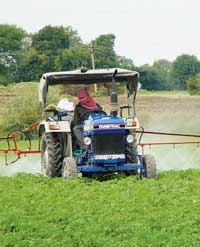 It would be unfair to compare Indian agriculture with that in Northern Europe but inevitably mechanisation is a good 30 years behind in most cases. This is perhaps not surprising when farm labour costs less than $1/day and generally it is cheaper to hand weed and use knapsack sprayers than to buy and maintain more up-to-date machinery.
It would be unfair to compare Indian agriculture with that in Northern Europe but inevitably mechanisation is a good 30 years behind in most cases. This is perhaps not surprising when farm labour costs less than $1/day and generally it is cheaper to hand weed and use knapsack sprayers than to buy and maintain more up-to-date machinery.
However, that is changing and in an article written by Prof Swaminathan (the grandfather of the Green Revolution in India) in the Times of India last month he stated that “two-thirds of India’s population live in [rural] villages” but “in a recent survey over 40% of farmers interviewed expressed the desire to quit farming”. You can do the maths.
People movement from rural to urban environments will leave a shortage of labour and an urgent need for more efficient production and technological advances.
With this comes opportunities for improved crop production using new technologies such as innovative crop protection products, mechanisation and, in the case of India, GM technology in the form of BT cotton.
However, there is a risk that if change happens too quickly farmers will not have the tools in terms of knowledge and education to protect both themselves and the environment.
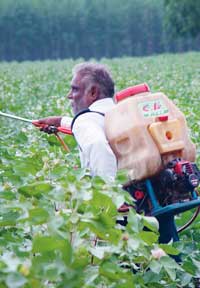 BASF India, alongside its launch activities to farmers for Stomp Xtra, presents a video which highlights all the do’s and don’ts on how to handle pesticides safely.
BASF India, alongside its launch activities to farmers for Stomp Xtra, presents a video which highlights all the do’s and don’ts on how to handle pesticides safely.
The video may seem basic to us but it puts across very important messages that haven’t been heard here before. It is understandable in a tropical environment farmers applying sprays would historically not wear protective clothing.
However, this is no longer acceptable both in terms of human health but also how they manage pesticides in the environment. Those using pesticides in India need to be aware of not only how to protect themselves with personal protective equipment but also what to do with empty pesticide containers, waste material and how to target the right product for the right situation.
Although Paul and I were able to help give advice in many areas, there were still one or two that stumped us. How do you advise a farmer who wants to apply a pesticide with a knapsack sprayer in a mature crop of soya when the main threat is snakes? We offered to go away and think about that one.
Indian farmers are supported by their government to employ Integrated Pest Management approaches, although it is still early days. Farmers are taking on board the real benefits from using modern products. We saw a really good example in a chilli crop where production had nearly doubled compared with when they used no pesticides at all.
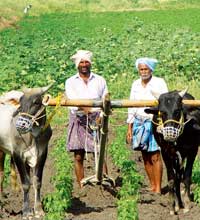 We found that Indian farmers have an infectious enthusiasm for new ideas and like all farmers across the world are fascinated by machinery and how to modify it to best suit their needs. It is maybe hard to believe that a farmer with an old example of an ox-drawn sprayer, which he still uses, could be considered to be an “early-adopter”. He has now invested in a tractor-mounted sprayer – albeit it designed and built in the local village and I’m sure if we go back in a few years’ time he will be one of the first to have a self-propelled sprayer.
We found that Indian farmers have an infectious enthusiasm for new ideas and like all farmers across the world are fascinated by machinery and how to modify it to best suit their needs. It is maybe hard to believe that a farmer with an old example of an ox-drawn sprayer, which he still uses, could be considered to be an “early-adopter”. He has now invested in a tractor-mounted sprayer – albeit it designed and built in the local village and I’m sure if we go back in a few years’ time he will be one of the first to have a self-propelled sprayer.
Some of the larger farmers are now starting to work together to share equipment, particularly combines and drills. There is certainly no shortage of tractors although most of them seemed to be used for many purposes other than farming. For example, doubling as the school bus or as the main form of transport into the local village.
Farmers in India have a great understanding of their crops, great humour and tenacity, and I think now a real opportunity to have a sustainable agricultural system despite the challenge that climate change may bring.
I would like to think in a small way Paul and I have helped to contribute to that by increasing both the awareness of the farmers, as well as colleagues in BASF India, as to the importance of education about how to use and handle pesticides as well as the vital role that stewardship plays in agriculture in the 21st century.
See more pictures from Rosie and Paul’s trip
Dr Rosie Bryson is BASF development manager for UK, Ireland and Nordic and Baltic countries.

